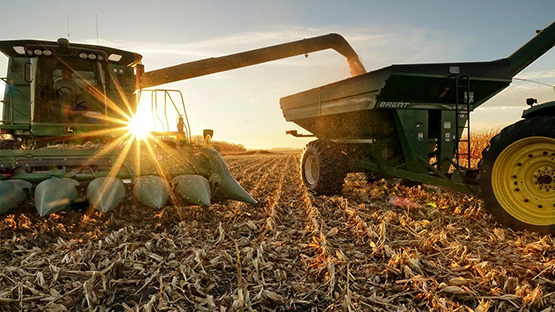
The latest USDA World Agricultural Supply and Demand Estimates (WASDE) and Crop Production reports came out yesterday and have resulted in more questions than answers for many. Regardless of what a person believes after seeing the reports, these are the facts as far as the market is concerned. Keep in mind that they may change over time, but betting on that is a risk and not a management strategy.
Given the levels we saw through June and July, let’s hope guys made some sales of corn at the time. Odds are good they probably didn’t sell everything, but they should be fairly well along in terms of pricing out their APH. That said, we are getting carry back in that market. As of August 13th, we have 26 cents of carry between December of 2019 and July of 2020. Anything 27 or better starts to look attractive as a roll opportunity (70% of 38 cents, which is full cash carry). We need to remind farmers that they will have cash needs and possible storage issues if they didn’t clear out 2018 inventory. With that said, this is a good opportunity to make their best sales better if they can.
There’s a lot of questions and theories about why the numbers are so far apart between reports. It’s important to understand that this is not an apples to apples comparison:
- NASS’s definition of planted corn acres and FSA’s definition are not the same.
- NASS’s numbers include those acres NOT enrolled in the farm program; FSA’s numbers do not. Remember while most producers are enrolled, there is a percentage that aren’t.
- FSA acreage historically is not complete until October for major crops. This is due to different states having different reporting dates, the information has to be compiled, guys filled revised 578’s, etc.
Historically, these numbers will not reconcile. They never do. It’s more helpful to compare FSA to FSA over time and NASS to NASS over time. Additionally, while NASS won’t revise the August report, we have to understand what this report is - an estimate that has a margin of error. When USDA says 90 million acres of corn has been planted and the yield on those acres is 169.5 bushels, they also give a confidence interval. In the case of corn, USDA’s 90% confidence interval is 6.2%. So what USDA is really saying is that their models predict total 2019 production will be 13.9 bushels, and they are 90% certain it will be between 13.03 and 14.76 bbu. That’s a big range, so they further say that over the past 20 years, our “average” miss between August and the final estimate is 305 mbu. So in an “average” year, the range is really 13.6 to 14.2 bbu.
FSA does not have a margin of error, because this isn’t an estimate. They are simply reporting what’s on their books right now.
That’s the short version, but the point is we will still have movements in the estimates. However, at this time the momentum has shifted and the proximity to harvest means it’s now incumbent upon market bulls to prove there is an actual issue.
Corn
The report shows a total planted area of 90 million with harvested area of 82 million. That’s a roughly average amount of harvested acres as a percentage of planted. If there’s a case to be made where USDA might make further changes, that’s probably the best candidate. When it comes to yield, USDA’s estimate of 169.5 bushel an acre was also a surprise to the market. The states with the largest percentage yield drops are Illinois (181 predicted compared to 210 last year), Ohio (160 compared to 187 last year), and Indiana (166 compared to 189 last year). For interests sake, North Dakota yield are predicted at 146 bu/ac (down 4.6%), South Dakota predicted at 157 (down 1.9%), Minnesota at 173 (down 4.9%) and Wisconsin at 165 bu (down 4.1%).
On the balance sheet, USDA is reflecting that higher prices have cut into the demand outlook and I can’t argue. Corn use for ethanol was reduced by 5.5 mbu and exports were down because of increased competitiveness of South American and Ukraine. What’s not mentioned that’s also effecting this is the strength of the U.S. dollar.
Globally, increased production estimates for Ukraine were ramped up. South American production was unchanged, but they had tremendous shipments compared to their historical pace this time of year and demand out of China was decreased.
Soybeans
Planted area in this category was reduced to 76.7 mbu while yield was unchanged 48.5 bu compared to last month, and 3.1 bushel less than last year. The largest reductions in yield compared to last year were again in Illinois, Indiana, and Ohio. North Dakota yield is projected down slightly at 35 bu (35.5 bu last year); South Dakota at 45 bu (46 bu last year); Minnesota 46 bu (50.5 bu last year); and Wisconsin at 47 bu (49 last year).
On the balance sheet, the good news is that we continue to lose some stocks because of the lower production. We’re still too high at 755 mbu, but much better than the 1.07 bbu projected for the 2018 crop year. Unfortunately, exports were reduced by another 100 mbu, so it’s clear we still have an uphill battle on demand. However, we’ll take what we can get at this point. Average price was unchanged at $8.40 (NOTE: This is the trigger price for a PLC payment).
Wheat
All wheat production is forecasted up from both last month and 2018. All Wheat yield is 51.6, which is 4 bushel better than last year and 1.6 bu better than last month. Winter wheat accounts for some of this although there are admitted quality problems in the SRW crop that is not discussed in the production report. As for spring wheat, USDA raised the yield 2 bu from last month and 0.9 bushel from last year to 49.2 bu/ac. Durum yield is projected at 42.3 bu, which is 3 bushel better than last year. Overall, durum production is still down sharply because of lower planted area this spring when it was cheaper than HRS.
On the balance sheet, wheat is still struggling. The U.S. did, however, pick up some demand because of minor crop issues in the European Union, Russia and Kazakhstan. Like soybeans, the good news is we are projected to decrease the carryout from 1.072 bbu in 2018 down to 1.014 bbu in the 2019 crop year. Unfortunately, prices are still projected to come in lower at $5.00 - a 20 cent loss from the July estimate. This is further proof that the market operates on a lot of influences, not just pure supply and demand.
Hard Red Spring wheat balance sheets are calling for 323 mbu ending stocks in 2019, which is basically even with last month. It’s a large increase from 2018, however, with Stocks to Use from 45.6% to 56.2%.
If you have any questions, please contact your local AgCountry office.



